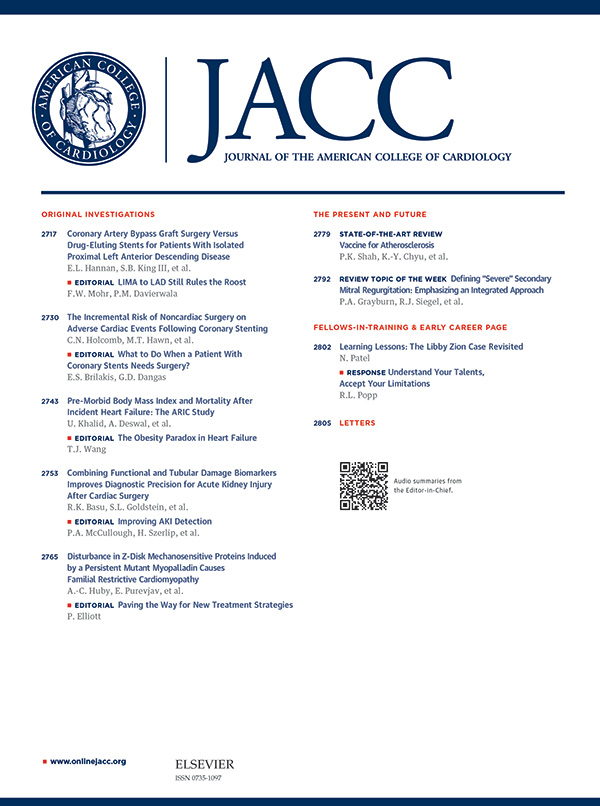Effect of ANGPTL3 Inhibition With Solbinsiran in Preclinical and Early Human Studies
IF 21.7
1区 医学
Q1 CARDIAC & CARDIOVASCULAR SYSTEMS
引用次数: 0
Abstract
Background
The residual cardiovascular risk associated with hypertriglyceridemia and remnant particles supports efforts to develop effective novel therapeutic approaches. Angiopoietin-like protein 3 (ANGPTL3) inhibits lipoprotein and endothelial lipases, and Mendelian randomization studies associate lower ANGPTL3 activity with lower triglycerides, and lower cardiovascular risk.Objectives
The aim of this study was to evaluate the impact of solbinsiran, an N-acetylgalactosamine-conjugated small interfering RNA developed to inhibit hepatic translation of ANGPTL3 messenger RNA (mRNA), on ANGPTL3 and lipid levels in preclinical models and humans.Methods
In preclinical studies, the impact of solbinsiran on ANGPTL3 levels was assessed in mouse and nonhuman primate models. The phase 1 clinical study enrolled participants with mixed dyslipidemia. In the single-ascending-dose study, participants received single subcutaneous doses of solbinsiran (24-960 mg) or matching placebo. In the repeat-dose study, subcutaneous solbinsiran (208 or 480 mg) or matching placebo on days 1 and 29 was evaluated. Safety, pharmacokinetics, and effect on levels of ANGPTL3 and lipid parameters were evaluated over 169 days.Results
In mice transiently expressing human ANGPTL3, a single dose of solbinsiran reduced hepatocyte ANGPTL3 mRNA expression by 65% vs vehicle-treated mice. In cynomolgus monkeys, mean ± SEM reductions in hepatic ANGPTL3 mRNA expression up to 73% ± 2% (P < 0.0001) and serum ANGPTL3 protein expression up to 69% ± 4% (P < 0.001) were seen vs vehicle-treated monkeys. In humans, a single dose of solbinsiran resulted in dose-dependent mean ± SD percentage reductions from baseline in ANGPTL3 up to 86% ± 4%, triglycerides up to 73% ± 7%, low-density lipoprotein (LDL) cholesterol up to 30% ± 16%, non–high-density lipoprotein cholesterol up to 41% ± 12%, and apolipoprotein B up to 30% ± 11%, with sustained effects at higher doses (P < 0.0001 for all). The repeat-dose study demonstrated reductions in ANGPTL3 of 89% ± 6%, triglycerides up to 70% ± 13%, LDL cholesterol up to 42% ± 14%, non–high-density lipoprotein cholesterol up to 46% ± 14%, and apolipoprotein B up to 36% ± 13% (P < 0.0001 for all). Nuclear magnetic resonance lipoprotein analysis demonstrated reductions in the total number of triglyceride-rich lipoprotein and LDL particles with solbinsiran. Adverse events were mostly mild in severity, with similar incidence in solbinsiran- and placebo-treated participants.Conclusions
Solbinsiran inhibits hepatic ANGPTL3 translation and results in significant reductions in all atherogenic lipoproteins in mixed dyslipidemia. The impact of this approach on cardiovascular outcomes remains to be determined. (A Study of LY3561774 in Participants With Dyslipidemia; NCT04644809)

求助全文
约1分钟内获得全文
求助全文
来源期刊
CiteScore
42.70
自引率
3.30%
发文量
5097
审稿时长
2-4 weeks
期刊介绍:
The Journal of the American College of Cardiology (JACC) publishes peer-reviewed articles highlighting all aspects of cardiovascular disease, including original clinical studies, experimental investigations with clear clinical relevance, state-of-the-art papers and viewpoints.
Content Profile:
-Original Investigations
-JACC State-of-the-Art Reviews
-JACC Review Topics of the Week
-Guidelines & Clinical Documents
-JACC Guideline Comparisons
-JACC Scientific Expert Panels
-Cardiovascular Medicine & Society
-Editorial Comments (accompanying every Original Investigation)
-Research Letters
-Fellows-in-Training/Early Career Professional Pages
-Editor’s Pages from the Editor-in-Chief or other invited thought leaders

 求助内容:
求助内容: 应助结果提醒方式:
应助结果提醒方式:


